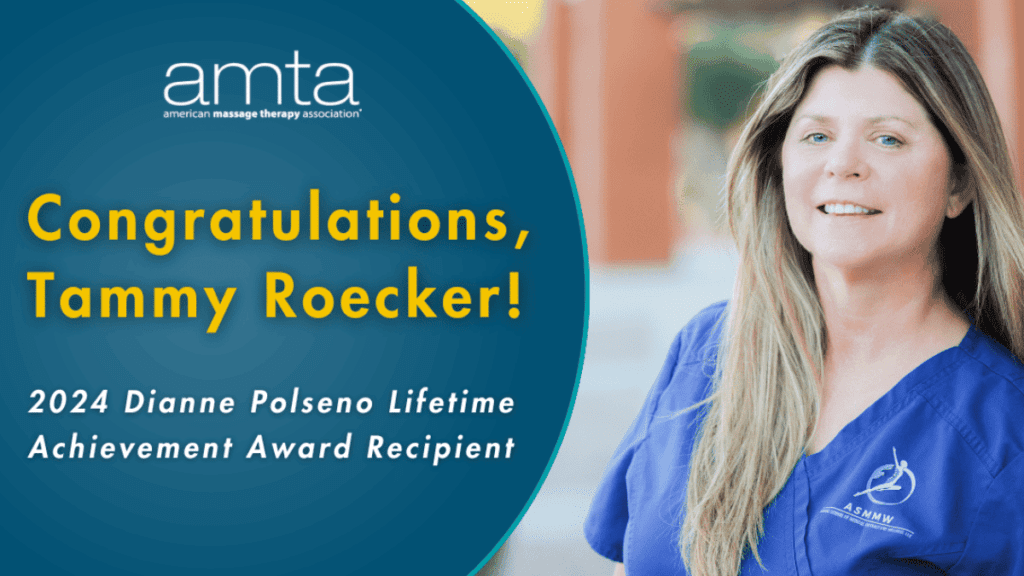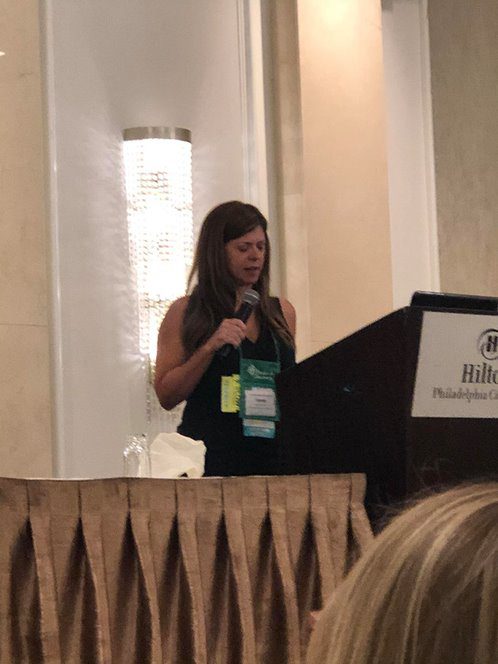Meet Tammy Roecker, CMBE, APCE, LMT

I’m excited for you to begin a career you can be as passionate about as I am and have been for 32 years! There’s nothing more rewarding than helping others resolve their pain and achieve wellness!
I am equally passionate about quality education, and I am here to help you through every step of the way.
When you’re ready, I’ll work with you to ensure the process — from enrollment to graduation — is seamless and successful!
Contact me with any questions.
Call for a tour! 800-615-1342

This year, AMTA has awarded Tammy Roecker, President of the Arizona School of Medical Massage and Wellness, with the Dianne Polseno Lifetime Achievement Award, recognizing her outstanding contributions to massage therapy education. Tammy has demonstrated unwavering professionalism, integrity, and leadership as a Licensed Massage Therapist (LMT) in Arizona for over 32 years and is Board Certified in Therapeutic Massage and Bodywork (BCTMB).
Tammy’s Dedication to Massage Therapy Education
Tammy’s dedication to massage education is evident in her extensive credentials and accolades, including achieving the Certified Massage and Bodywork Educator (CMBE) credential and being named the Alliance for Massage Therapy Education’s (AFMTE) 2019 Continuing Education Provider-Educator of the Year! For 17 years, she has provided continuing education to not only Licensed Massage Therapists but also to a wide range of healthcare professionals, including RNs, OTs, PTs, and LCSWs. She has also been an active AMTA member for over 30 years.
Integrating Massage Therapy into the Medical Healthcare Community
Tammy’s vision of integrating massage therapy into the medical healthcare community came to fruition in 2022 with the establishment of the Arizona School of Medical Massage and Wellness. The school, which graduated its first cohort in 2023, aims to prepare graduates to work with individuals suffering from injuries, pain, and medical conditions. As she continues to expand her school, including a new location in Tucson, Tammy remains focused on bridging the gap between massage therapy and conventional medical care.
In addition to her contributions to massage education, Tammy is the founder and president of the Early Bonding Foundation, a non-profit 501(c)(3) organization. Through this foundation, she has organized workshops and developed custom curricula focused on the care of medically fragile infants, children with developmental delays, and individuals with ADHD. Her work with various health organizations, including the Arizona Nurses Consortium and the Arizona Department of Health Services, has had a significant impact on community health, particularly in underserved populations.
“We are delighted to recognize Tammy for her many years of outstanding contributions to massage therapy education and service to her community,” said AMTA President, Kim-Kane Santos. “Teachers like Tammy are vital to inspiring and developing the next generation of massage therapists in the profession.”
About the Dianne Polseno Lifetime Achievement Award
AMTA’s Dianne Polseno Lifetime Achievement Award is an honor bestowed on an instructor in an AMTA member school who has manifested a history of unquestionable leadership, volunteer service, professionalism, integrity and a commitment to research to advance the massage therapy education profession.
Educator of the Year 2019!

Tammy Roecker has been a self-employed, Arizona State Licensed Massage Therapist (LMT), NCBTMB Board Certified in Therapeutic Massage and Bodywork (BCTMB), and an active member of the American Massage Therapy Association for 30 years with additional certifications in Pre/Peri-Natal Massage, Doula, Childbirth Educator, as well as being a Certified Personal Trainer with extra training in Perinatal Fitness.
Tammy is a CMBE (Certified Massage and Bodywork Educator) and was honored as the AFMTE’s (Association For Massage Therapy Education) 2019 Continuing Education Provider-Educator of the Year!
Tammy Founded the Early Bonding Foundation and serves as the president of the non-profit 501c3 Corporation, aa well as, TR Seminars, as a provider of continuing education for Licensed Massage Therapists, RNs, OTs, PTs, LCSWs, and other Healthcare Professionals. She has been providing continuing education since 2011 and currently has many classes with a wide variety of subjects from pediatrics to geriatrics.
Teaching Philosophy

Teaching Philosophy, by Tammy Roecker, CEP, LMT
The purpose of this statement is to describe my approach in teaching massage therapy in a somatic-based classroom. The statement will show how my philosophy aligns with AFMTE’s core competencies, as it relates to the role of educator and learner, evidence-based content and knowledge, and useful teaching strategies and assessments in massage therapy education. These challenges will be summarized as they relate to my responsibilities and intentions as a Certified Educator of Therapeutic Massage and Bodywork.
My role as an educator is to facilitate learner development and well-being through a combination of learning activities, critical thinking skills, and experiential exercises, which helps the learner build on existing knowledge and integrate curriculum content with career and life experiences.
Students deserve a safe, respectful learning space, a passionate teacher, and appropriate massage therapy education, that stays within their scope of practice, and that is supported by peer reviewed research. Providing a learning environment with structure, goals and objectives, assessment, evaluation and feedback to students can be challenging when there are such diverse groups of learners with different learning styles, and levels of prior education. Cultural and social backgrounds, special cognitive or physical needs also require multiple approaches.
It has been proven that each individual has a different way of learning, and their learning ability could be a lot faster, if they are able to make use of their preferred learning style (Bhagat et. al, 2015).
According to Peyman, the four basic learning styles associated with V.A.R.K. learning style preferences are: Visual (looking at and making pictures, animations, graphs, tables, ); aural (listening to and participating in speeches, discussions, and question answer sessions); read/write (reading and writing text associated with the textbook, class notes, laboratory reports, etc.) and kinesthetic (engaging in physical experiences, manipulating objects, laboratories (Peyman et al., 2014).
Learners build on existing knowledge by interpreting new information through personal feelings and prior experiences. Students employ a variety of learning styles and have diverse educational needs; they come to the learning space with a variety of perspectives, expectations, and motivations. Students who take an active role in learning acquire important skills and are open to continuous learning to improve their practice.
My classes include lecture with PowerPoint presentations, and technique demonstration followed by Learner kinesthetic practice. Lectures are both auditorily informative, and interactive through question and answer, but also visually pleasing through PowerPoint presentations and my animated, storytelling from personal experience. Learners get visual, auditory and kinesthetic models of learning, and combining all three, to see it, feel it, and do it; followed by my formative and summative assessments.
Live classes are mainly kinesthetic or hands-on learning, working with your hands. Lectures are mainly online Zoom and pre-recorded lectures you can watch and participate in, from the comfort of your own home.
The most useful strategies are those that help the learner integrate knowledge with experience. Teaching, in my opinion, is 50% knowledge and 50% presentation; both need to be spot on. Knowledge on a subject is critical, but so is the ability to think on your feet. Having two or three ways to explain the same idea, having good people skills, as well as the ability to read the room, and throw away the script, and speak directly to the group’s dynamic, is important.

